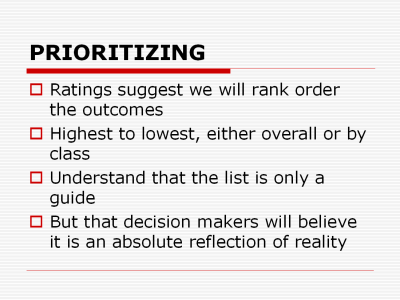| front |1 |2 |3 |4 |5 |6 |7 |8 |9 |10 |11 |12 |13 |14 |15 |16 |17 |18 |19 |20 |21 |22 |23 |24 |review |
 |
Whether based on a qualitative or a quantitative approach, the result is
a rating for each hazard.
This suggests that the hazards should be rank ordered
from highest hazard to lowest hazard.
The highest hazard is positioned first so that readers will see
it first; a reverse order makes it likely the reader will not read the
end of the list. If doctrine or
political factors require that general classes of hazards are reported
separately, the rank order is within the class.
However, a more realistic approach is to rank order the entire
list of hazards.
For an emergency manager this list is a guide. The difference between two potentially catastrophic hazards is not material – you have to prepare for both. You may be constantly reordering the list in your mind based on more current information. Decision makers and non-specialist readers of the hazard analysis may believe that the list reflects an absolute and fixed reality. In their minds, number 1 on the list is really what has to be addressed first. It also is the event that will happen first, even though events 1 through 4 have operationally the same probability of occurrence and the same effective potential to devastate the community. Part of your challenge is to educate the list user to understand the list. |